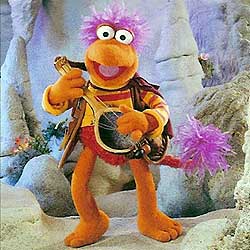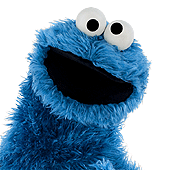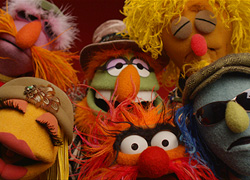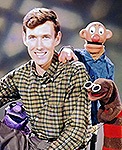LouisTheOtter
Well-Known Member
- Joined
- Jan 25, 2012
- Messages
- 326
- Reaction score
- 511


Left: An official Sesame Street merchandise image created by longtime MAD Magazine artist Jack Davis, who illustrated two of the magazine's parodies of the show in the 1970s. Right: The only time, as far as I know, that a Muppet appeared on a regular-issue MAD cover - this one published in the U.K. and Germany in the early '80s.
I’ve been a fan of The Muppets for nearly four decades and a MAD Magazine reader/subscriber for nearly three decades, and both long-running franchises are marking significant milestones right now.
Of course, we all know that The Muppets reached their 60th anniversary on May 9, just one day after the characters’ new series was confirmed for a full-season order by ABC, marking their first regular prime-time slot in 17 years. This is all happening nearly a quarter-century to the day that the Muppets’ creator and brain trust, Jim Henson, died suddenly and shockingly at the age of 53.
Meanwhile, MAD is arguably getting its highest exposure in several years thanks to a gutsy editorial move that crystallized with the appearance of issue #533 on newsstands and in subscribers’ mailboxes (and iPads) last month. “Weird Al” Yankovic was chosen as MAD’s first-ever guest editor, and apart from the buzz expected from such a convergence of iconic comedy forces, the landmark issue is staying in the public consciousness through a variety of promotional gimmicks, including an April autograph session featuring Al and the MAD staff at a Barnes & Noble location in NYC. It’s also being offered free to those who order a T-shirt featuring the issue’s cover art and going on sale at venues around the world that host Al’s recently-launched tour.

Since both MAD and The Muppets have enjoyed rises and falls in popularity over the decades and have each faced their own struggles to remain relevant in the increasingly-crowded field of comedy and satire, I was inspired to trace the not-all-that-different paths each has traveled since their respective launches in the ‘50s. In that spirit, I've decided to post it concurrently on the MAD Mumblings forum, www.madmumblings.com - which I've co-moderated for the past 11 years - and here on Muppet Central.


For starters, each franchise actually got their start as a matter of convenience and timing. MAD’s first editor, Harvey Kurtzman, launched a comic book that parodied other comic books in 1952 as a means of adding to the income he was receiving for his work on other EC comic titles. Three years later, as Kurtzman was transforming MAD into a magazine, a teenage Jim Henson was hoping to break into television and, while he didn’t see himself specifically as a puppeteer, he seized an opening at a Washington, D.C. station by pitching a five-minute nightly puppet-comedy venture called Sam and Friends that would follow the late news.


In a similar vein, both franchises’ best-recognized characters began their lives as bit players. Alfred E. Neuman didn’t even have a name when he randomly showed up as clip-art in MAD’s comic and magazine formats. It took Al Feldstein, who replaced Kurtzman in 1955, to see the gap-toothed kid’s potential, hire a distinguished artist named Norman Mingo to flesh out the face that had surfaced in ad campaigns for everything from soda to painless dentists to political candidates since the late 1800s, and marry it with the name and the slogan “What, Me Worry?” on the cover of MAD #30 (December ’56).
Likewise, Kermit - hastily created after Henson cut up his mother Betty’s coat - wasn’t the Sam and Friends host, and wasn’t even recognized as a frog for the first 14 years of his existence. Despite his starring role in several late-‘60s/early-‘70s Muppet TV specials, Kermit the Frog didn’t get the hosting job in either of The Muppet Show’s pilots (The Muppet Valentine Special in 1972 and The Muppets: Sex and Violence in 1975). It wasn’t until the series began its five-year run in 1976 that the affable amphibian took a central role in The Muppets that has rendered him the face of the franchise for the following four decades.

In the ‘60s, both MAD and The Muppets grew and thrived because of the supporting cast assembled around their driving forces. Already enjoying the contributions of artists Don Martin, Dave “The Lighter Side” Berg, Bob Clarke, Mort Drucker, George Woodbridge and Frank Kelly Freas, as well as writers Larry Siegel, Arnie Kogen, Tom Koch, and Frank Jacobs, MAD would add even more soon-to-be-iconic names to their roster such as artists Angelo Torres, Sergio “Marginal Thinking” Aragones and Antonio “Spy Vs. Spy” Prohias and writers Dick DeBartolo, Stan Hart and Lou Silverstone. Artists like Jack Davis and Al Jaffee (“Snappy Answers To Stupid Questions”/”The MAD Fold-In”) would also return to The Usual Gang of Idiots after briefly toiling for publications Kurtzman launched once he left MAD in 1956.
Similarly, Henson spent the ‘60s attracting talent that would remain with the Muppet family for decades - including puppet builder Don Sahlin, writer Jerry Juhl, and Muppet performers Frank Oz, Jerry Nelson and Carroll Spinney. The latter three would prove particularly instrumental in launching and solidifying a major Henson venture as the decade concluded - the introduction of the Muppets as major components of Sesame Street. By that time, however, The Muppets were already building a following through their appearances in TV commercials and on variety programs such as The Ed Sullivan Show and The Jimmy Dean Show (where Rowlf the Dog was pulling in even more fan mail than Dean himself).

The ‘70s are seen by many as the “golden era” for both MAD and The Muppets. The magazine reached a highwater sales mark of 2.1 million in 1973 (specifically, issue #161) and its well-established contributors and staff, including publisher William M. Gaines, were becoming cult heroes in their own right. In addition to eight regular issues and four reprint issues per year, MAD also continued a string of popular paperback books - split between reprints of magazine articles and all-new material devised by its writers and artists - and expanded on earlier merchandising efforts, even releasing a MAD board game and card game in the late ‘70s.
In the meantime, Henson’s efforts meant the Muppets were pretty much everywhere. Sesame Street blew up as a cultural phenomenon, proving itself to be a merchandising bonanza and attracting everybody from James Taylor to Julie Andrews to work with Ernie, Bert, Big Bird et al. After tirelessly pitching The Muppet Show to every available U.S. network, Henson secured the financial backing of British lord Lew Grade, worked out a syndication deal, and officially “played the music and lit the lights” for the first time in 1976. The series turned down by everybody was suddenly a runaway hit, attracting A-list guests, airing in over 100 countries, and spurring Henson to shift to the big screen in 1979, with The Muppet Movie grossing an astounding $216 million (adjusted for inflation) and cementing the characters as beloved icons.
(Footnote: MAD also lent its name to a movie, Up The Academy, in 1980. The less said about that, the better.)


By the ‘80s, MAD and The Muppets were still rolling but found themselves adjusting to a changing cultural landscape. The magazine’s circulation had dropped by 50 per cent from its 1973 record high to just over a million in 1982, facing fierce competition from the likes of MTV, arcade games and home computers. Publisher Gaines told Newsweek: “We’re still basically a kids’ magazine, and I guess there just aren’t as many kids around as there used to be.” Editor Feldstein retired in late 1984, paving the way for new editorial direction under incoming co-editors Nick Meglin and John Ficarra, who retained many of the artists, writers and formats that had been with the magazine for decades but faced constant criticism - as had Feldstein before them - that MAD had lost its humorous edge over the years.
The Muppets, for their part, enjoyed success with two more movies and a series of TV specials after The Muppet Show wrapped in 1981, and Sesame Street showed no signs of slowing down, even though the first theatrical film based on the show, Follow That Bird, fared poorly at the box office in 1985. However, after years of cheerfully poking fun at mass media, the neo-Vaudevillian Muppet shtick didn’t always wash with the great unwashed; Henson biographer Brian Jay Jones pointed out that the one-season NBC experiment The Jim Henson Hour was especially disappointing for the Muppet impresario, because it wasn’t a matter of experimental non-Muppet films like The Dark Crystal or Labyrinth failing to click with audiences - for the first time in Muppet history, “Kermit was tanking.”

Both franchises have fallen under corporate ownership over the years. Henson had inked a deal to sell the main Muppet Show characters to Disney prior to his death in 1990 (he fiercely fought Disney CEO Michael Eisner to keep Sesame Street off the bargaining table); this endeavour collapsed in the months following his demise, but the Mouse House collaborated with Jim Henson Productions several times throughout the ‘90s and eventually bought the rights to The Muppets in 2004, excluding Henson’s Sesame Street and Fraggle Rock characters. The former remain under the auspices of Sesame Workshop, while the latter are owned by The Jim Henson Company.

(Above: One of several variant covers illustrated by MAD artists for DC Comics titles in 2013 and 2014, as a tie-in to April Fool's Day. This one is courtesy of Tom Richmond.)
The MAD ownership changes began much earlier: Gaines sold EC Publications to the Kinney Parking Company in the early ‘60s. Kinney cast its net a bit wider by the end of the decade, purchasing Warner Brothers and DC Comics. By the late ‘70s, MAD was firmly ensconced within Warner Communications (which did not escape the attention of MAD writers assigned to parody such Warner bombs as Superman III) and, shortly after Bill Gaines’ death in 1992, Time Warner executives informed MAD that the magazine would now exist under the DC Comics banner, where it remains one of the company’s best-selling titles to this day.


A key struggle shared by both MAD and The Muppets is the occasionally-daunting legacy left behind by their founders. Jim Henson’s 1990 death from the rare Group A streptococcus stunned a world that had grown up loving his characters. While Henson’s family and his former colleagues continued the work he had begun, eventually paving the way for new characters and performers to join the Muppet family, a stubborn sector of the fan base still insists The Muppets will never recapture the wit, heart and entertainment value of the Henson era.
Gaines did not play as pivotal a role in MAD’s content - he introduced a 1986 TV satire by gaily announcing that “I don’t even read” the magazine and “all I care about is how many copies of MAD we sell” - but his gregarious spirit, his fierce loyalty to MAD’s staff and contributors, and his insistence that MAD spare no cultural or social sacred cows linked him inextricably with the magazine’s image and reputation. Despite several months of declining health, his passing in mid-1992 shook up both MAD’s staff and its readership. While MAD has continued, and often improved upon, its history of bringing the world’s best visual satirists together for razor-sharp skewering of pop culture, politics and society in general, many insist that Gaines would not have approved of the changes made to the magazine since his death, most notably the introduction of paid advertising and the change from black-and-white newsprint to a glossy colour package in early 2001.


Another problem routinely encountered by both franchises - as is often the case with long-running entertainment staples that often mine the nostalgia vein to retain and keep fans - is that their original characters, features and tone are so beloved, little room for creative development remains. MAD has slowly incorporated more politically-charged, sexually-explicit and violent imagery over the past two decades, partly to reflect a changing cultural landscape that has welcomed the likes of Howard Stern, South Park, Grand Theft Auto, The Walking Dead and Fifty Shades of Grey with open arms. The attempt to balance this range of material with the underlying premise that MAD’s core audience is aged roughly 12-20 - in addition to adults who cherish their childhood memories of MAD - has not always bore fruit; a handful of long-time contributors ended their association with MAD shortly after its much-trumpeted 1997 “re-launch,” although it can be argued that many of these were nearing the end of their writing and illustrating days regardless of the magazine’s editorial direction.

(Pepe and one of his most frequent paramours, Good Morning America's Lara Spencer. Of course, Muppet fans have also seen him cuddle up to Lady Gaga, Joan Cusack and Bonnie Hunt over the past two decades...)
The Muppets and their various backers have always straddled the fine line between family-friendly fare and cheeky-but-clean humour for adults, and the balance was not easily defined following Henson’s death. The emergence of the Latin-lover caricature Pepe The King Prawn as one of the most prominent new characters of the past quarter-century has delighted some fans and rankled others, a Gonzo line regarding his Tin Man suit’s “nipples” in The Muppet Wizard of Oz still gives many fans the night shakes, and some Muppet contributors have anonymously expressed doubt about the use of mild scatological humour - Fozzie Bear’s “fart shoes” and Gonzo’s line of used toilets - in the PG-rated 2011 film The Muppets. Amid the nearly-universal positive reaction to ABC’s full-season order for the new Muppet series, some corners of the fandom have expressed concern with the network’s desire to present a “more adult” situation for the characters, even allowing Kermit to utter the word “****” for the first time in 40 years.

It can be said that MAD has been blessed and cursed by having most of its core contributors remaining with the magazine for decades. While their quality of work has remained, for the large part, consistent through the years, MAD’s editors have struggled to reduce their workloads, deal with retirements and departures (such as the beloved Don Martin’s bolting to rival Cracked in 1987), and introduce fresh new faces. The past 25 years have seen the emergence of a new generation that not only preserves and treasures MAD’s tradition but adds their own spin to the proceedings, such as artists Tom Richmond (whose Lost parody is excepted above), Hermann Mejia, Rick Tulka, Sam Sisco, Ray Alma and Mark Fredrickson, and writers Desmond Devlin, Jeff Kruse, Scott Maiko, David Shayne, Kenny Keil, and even Daily Show head writer Tim Carvell.


Similarly, The Muppets’ various performers, writers and caretakers have struggled with the dynamics that followed Henson’s death in 1990. Many of his most prominent characters, along with those of long-time performer Richard Hunt (who tragically died of AIDS in 1992), were not recast for several years; the iconic Kermit, while capably performed by veteran Muppeteer Steve Whitmire, took a supporting role in many ‘90s Muppet projects, including three films and the two-season ABC effort Muppets Tonight. As with MAD, the departures and deaths of veteran players opened the door for new performers, most notably Bill Baretta, whose stable of characters includes newcomers Pepe and Bobo and Henson-originated Rowlf and Dr. Teeth, as well as Eric Jacobson, now operating the bulk of Frank Oz's characters with the exception of Cookie Monster (expertly performed by David Rudman, who's also breathing new life into Scooter and Janice), and Matt Vogel, who has also taken on many of the “classic” Muppets but also notably performed the evil Kermit doppelganger Constantine in the franchise’s most recent film, 2014’s Muppets Most Wanted.



So where does that leave us in 2015? Specifically, with two entertainment institutions that, from where I sit, have maintained their quality and are still received warmly in many corners of the world but struggle to maintain their place in the overall pop culture schematic and often find that their own worst enemies are their past successes.
MAD’s circulation currently sits at 7.1 per cent of its 1973 record-setting levels - that is, approximately 150,000 copies sold per month - and it appears on newsstands only six times a year, a schedule imposed by DC Comics in 2010 after the company scaled MAD back from a monthly to a quarterly schedule a year earlier. However, its shrinking fan base is a loyal and even rabid one, and the MAD brand is still a force to be reckoned with - the 60th-anniversary anthology Totally MAD topped the New York Times bestseller list, sparking a 2013 follow-up, Inside MAD, which invited a whack of celebrities (beginning with foreword-writer Judd Apatow) to contribute essays and choose their personal favourite MAD articles.

Both MAD and The Muppets have embraced the internet as they seek to fill the world with more of their unique brands of comic anarchy. MAD retooled its Web site in early 2011 as “The Idiotical,” a blog that sees MAD’s editorial staff uploading fresh and re-purposed MAD content daily to fill the two-month void between issues. And part of The Muppets’ comeback over the past decade has to be credited to its original YouTube videos, particularly a multi-character re-enactment of Queen’s “Bohemian Rhapsody” that racked up 20 million YouTube views in its first month of existence in late 2009 and has now been seen over 45 million times.

The standard MAD viewpoint of all-encompassing cynicism might not blend with the Muppets’ longstanding credo that sometimes it takes “just one person to believe in you,” but occasionally each franchise has benefitted from a single driving force. John Ficarra (above), who assumed full-time editorial duties in 2004 and now serves as MAD’s Executive Editor and Vice-Present, introduced The Fundalini Pages - an issue-opening grab-bag of shorter MAD premises - shortly after his editorship began, and followed this up with The Strip Club, a three-to-four-page showcase for newer MAD cartoonists, 16 months later. Both formats have welcomed a wide range of MAD newcomers, many of whom are still regulars at the magazine to this day.

Similarly, The Muppets can thank Jason Segel (above) and, more recently, Bill Prady for much of their current prominence. Segel badgered Disney for years before the company finally agreed to shoot The Muppets, the 2011 reboot that ended the cast’s 12-year absence from the big screen and tied 1981’s The Great Muppet Caper as the second-best-attended Muppet film of all time. Prady (below, bottom right), a former Jim Henson employee who had been knocking around a Muppet TV concept for the past decade, finally found a Disney executive willing to listen to his pitch just a few months ago, and as a result, we’ll see The Muppets as a weekly TV series beginning this fall on ABC.

So here’s to MAD Magazine and The Muppets, and may there always be room in this world for both of them.


 Welcome to the Muppet Central Forum!
Welcome to the Muppet Central Forum! Back to the Rock Season 2
Back to the Rock Season 2 Sesame Street Season 54
Sesame Street Season 54 The Muppets Mayhem premieres
The Muppets Mayhem premieres Bear arrives on Disney+
Bear arrives on Disney+ Sam and Friends Book
Sam and Friends Book